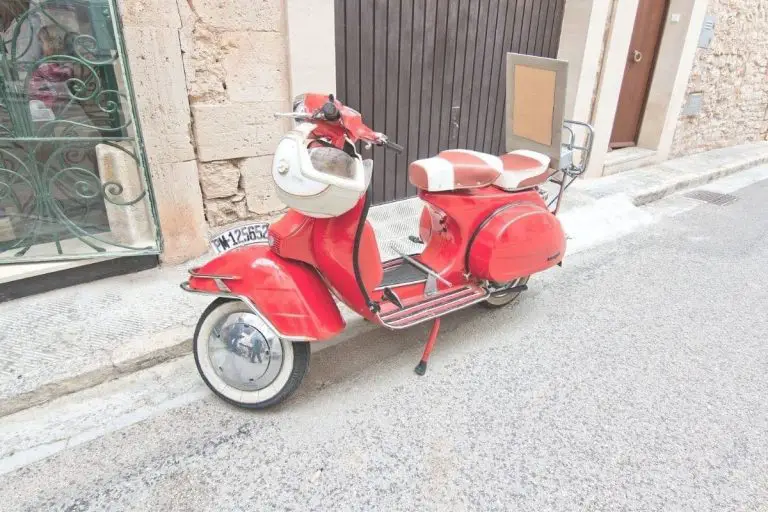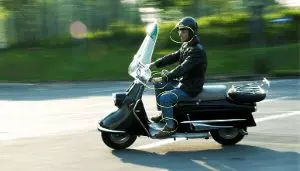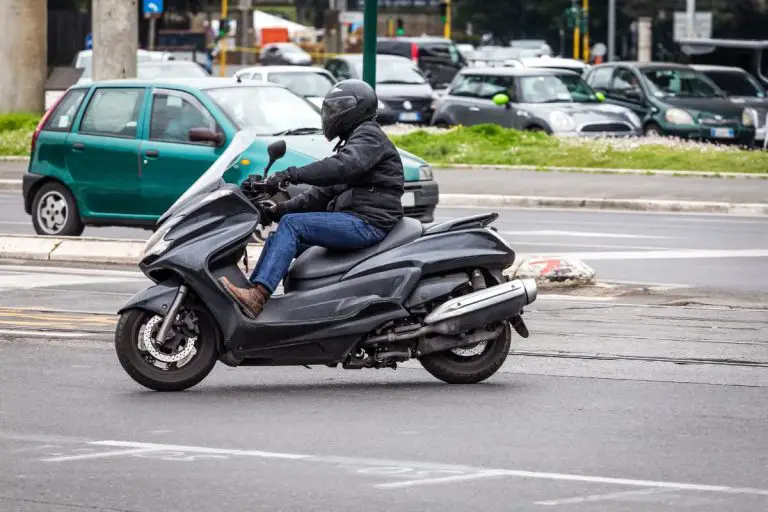Buying a helmet can be an overwhelming process if you have never shopped for one before. You are protecting your head and brain at a minimum by wearing one, so it is worthwhile to understand the differences between helmet options before you buy one.
The best value helmet options for scooters are the Bilt Force Eternity Helmet full face and the Sedici Aperto Helmet for the open face helmet. For more comfort and better safety certification, go with the Shoei RF-SR full-face helmet or the Shoei RJ Platinum-R open face helmet.
Wanna know what the average cost of a motorcycle helmet is?
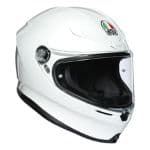
Top Helmet Pick
Lightweight, breathable, & available in more than just black (for visibility & heat deflection)
I’ve got a run down of my fav helmets based on budget and style at the end of the post, but my ultimate pick for value to safety rating is the Bilt Force. Check out the latest pricing on
Are there Certain Helmets Specifically for Scooters?
Good news! Nope! Scooter specific helmets are not a thing, but you will find a lot of scooter riders prefer the open face kind. A helmet protects your head, as well as, your face ideally.
Scooters are simply a type of street designated motorcycle, so your bases are covered by simply shopping for the right helmet for you.
This means that you can visit a motorcycle shop local to you to try helmets on or sites such as

Do I Have to Wear a Helmet?
All but 3 states in the United States have motorcycle (and therefore scooter) helmet laws, so it is likely you will need a helmet. Nineteen states require helmets completely.
So just over half of the states have helmet laws that depend on the age of the rider or size of the scooter or both.
You can find helmet law details for your state here.
Basic Parts of a Helmet
To shop for a helmet, it helps to know what makes up the helmet. It’s fairly basic, but the materials of each component will add to your safety and comfort. Keep this in the back of your mind, but when we talk helmet comfort, you’re thinking of fit, sound levels, and weight of the helmet (hello, neck muscles).
Outer shell
This is the rigid component that makes up the outside of the helmet. It serves as a barrier to keep anything from reaching your head. In addition, it is the first defense to help absorb any impact from reaching your head at full force.
Inner liner
This area is made of materials that absorb more impact in conjunction with the outer shell to spread the force of an impact. Think of it as dispersing energy to minimize what reaches your head.
Padding
This is the soft foam that you feel touching your head. It is primarily for comfort and fit benefits. It is helpful to choose a helmet that allows you to remove this component for easy cleaning or replacement.
Strap
This is the fastener that keeps the helmet on your head using D-rings. If you do not secure this, it is likely to come off in an impact. Strap your helmet every time you ride!
Helmet Types
There are a variety of sizes and shapes of helmets to try out. You are protecting your head from injury to varying degrees. Riding comes with risk, and wearing a helmet is a form of injury risk mitigation.
With that, the categories of helmet are listed from the most protection they provide to the least to help you understand what is available and allow you to decide where the intersection is for you between risk and comfort.
Just know that the average cost of a motorcycle helmet is not what you’d expect – a half helmet does not cost half of a full-face. More on that here.

Full Face
A full-face helmet covers the entirety of your face, head, and chin. This decreases the chance of injury from more angles than the other helmet options, and it also serves as protection from wind, water, and even noise.
Wearing a full-face helmet serves as built-in eye protection, so you can skip that protective gear if you go with this style of helmet.
Modular helmets are type of full-face helmet with a flip-up chin bar. Pull up to a light, and you can flip it up for some fresh air quite easily. More on the pros and cons of modular helmets here
Open Face, ¾
This is a helmet that covers the head in the back, top, and on the sides, but it leaves the scooterists’ face and jaw areas exposed. It tends to be a popular scooterist option and is viewed as a retro style. You will want goggles or a shield to snap-on for eye protection if you go this route.
Half
This type of helmet offers a minimum of protection, but it covers the top and portions of the back of a rider’s head. You will need to have goggles to prevent something from flying into your eye when driving with this style of helmet. It offers the least amount of protection for a helmet.
Safety Standards
Know that most countries have safety standards for helmets, and in the United States, the Department of Transportation (DOT) sets these standards. Europe’s helmets have safety standards set by the Economic Commission for Europe (ECE).
When shopping for a helmet, you will see a DOT designation at a minimum. You will see ECE when the helmet meets Europe’s helmet standards.
Both government agencies require testing, and generally, there is a feeling that ECE approval is stricter and therefore translates to a safer helmet. Each agency looks at different things and driving patterns such as speed play into these where Europe’s average crash speeds are lower than the United States. Each test for different impact points.
So many different variables that each agency has deemed important for their country’s safety! Which is right or wrong?
Like many other things, it depends on who you ask. What I do know is that crashes are nuanced and the specific details can be critical, so I error on the side of caution by looking at helmets that have both the DOT and ECE certifications at a minimum. You will see these on the back of the helmet at the bottom.
Another label you may see on a helmet is the SNELL rating. This symbol of approval was born from an accident in the 50s where a helmet failed to protect a driver, William Snell.
Out of this accident, the Snell Memorial Foundation was created as a non-profit that tests helmet performance to prevent helmet failure for others.
DOT certification on a helmet is required, but the Snell is voluntary. However, if you see the Snell certification on a helmet, it has gone through additional testing and is considered a gold standard for helmet safety.
The extra testing translates to extra expense, so you will not find budget value helmets with this certification.
Snell released a fresh round of certification standards in 2020, but the helmets with this certification are thin at the time this guide was compiled. M2015 is primarily what is on the market readily available.
If you do not see any of these designations, run!
Essentially, they do not meet safety standards and are classified as novelty helmets. There is a possibility of counterfeit certification labels, so check under the comfort liner for the certification as an extra layer of protection.
Beyond Safety Considerations
Comfort
Be ready to take your time when you are trying on helmets as you will want to hang out in each helmet for at least 5 minutes. I have been known to try on a helmet and walk around looking at other accessories when I am in a store. Try another helmet on, and then it is time to do another lap around the store. Don’t judge.
As you are trying the helmets on, you will want to pay attention to the weight. If it is heavy, you could get tired more quickly, particularly on longer rides. If you have back or neck concerns, this comes into play, as well.
Speaking of comfort… staying dry is important for visibility AND comfort. Full-face helmets are waterproof, but read here for details on whether motorcycle helmets are waterproof.
Fit
If it is your first time wearing a helmet, know that it is odd at first. They squish your cheeks by design to be a good fit, but you will get used to it.
Motorcycle helmets are intended to fit snug to stay on and absorb the energy of impacts but keep in mind that you should not have any irritating pressure points.
Snug, yes. Pain, no.
A helmet should not wiggle around on your head if you move your head from side-to-side or forward and back. The size and shape of the helmet will be the factor for movement, so be aware of these components as you try them on.
- Helmets come in size designations like clothes with Small, Medium, Large and more. Oh but motorcycle helmet sizes are not universal between brands.
- There are 3 helmet interior shapes, so change the shape if you experience any movement in either direction. The most common shape is Intermediate Oval, but Long Oval and Round Oval are also options to help with this movement.
Ventilation
If you are opting for a full-face helmet, you will want a helmet that allows for some air to flow. They can certainly get hot!
Aesthetics
Does the helmet look good? It is critical to pick a helmet for safety, but if those requirements are met, you can definitely let looks help you decide on which to cruise around with. There are so many to choose from, so have some fun with it.
It is always a good idea to pick out protective gear like a helmet so that it adds to your visibility on the road. If you are feeling like you need a slicker black model, look for one that also has some reflective components to help you be seen while scooting around town.
Read why white is the best motorcycle helmet color
Maintenance
Can you get replacement parts such as the chin strap or the comfort liner? Liners can get gross, and chin straps might fray. It is cheaper to replace components than replace a helmet if you need a little refresh from everyday wear and tear on components that are likely to wear out.
Taking Care of Your Helmet
Taking care of your helmet will keep it safer for longer, and you can find more detail on cleaning your helmet here.
Here’s the key details if you just need an overview:
- To clean your helmet, do not scrape the surface ever. If something is stuck on it, just let a damp towel sit on the problem area to help loosen the grime.
- Don’t use Windex or other random glass cleaners
- Wash removable pads when needed.
- The liner can wear out from normal use, so replace them using the manufacturer’s parts when needed.
When setting it down, put it bottom-side down & NOT on your seat!
More on storing your motorcycle helmet
Do not set your helmet on the seat. The impact from a fall just the height of your scooter could damage your helmet.
Check the shell and visor if this happens but know that the inner shell is designed to absorb only so much energy and essentially crushes in an impact. Falls are impacts.
You can not see the crushed foam, but the next time your helmet needs to absorb an impact (which hopefully isn’t your head impacting something), it will not perform as well as it would without the internal damage from what seemed like a minor fall from your scooter seat.
A Few More Thoughts on Your Helmet
Helmets are designed to reduce wind and engine noise, so they do not limit your hearing.
If you have an accident, you could have damaged internal components that you may not be able to see. This will limit the helmet’s ability to function as intended if it happens again, so just replace it!
DO NOT BUY A USED HELMET. Just at face value, helmet liners get nasty pretty quick. While the liners are intended to replace, you just have no idea if the inner shell has been damaged. It is not worth the risk to buy a used one. Remember – helmets get dinged up from normal use. You can’t see this damage, so do not risk buying one that you have no idea how it was banged around.
You will need to replace your motorcycle helmet from time to time based as the bumps it faces from regularly use crushes the inner shell in a way that you can not see but prevents it from working as good as it does when the inner shell is like new.
Read here on when to replace your helmet
Helmet Recommendations
I know there are some that do not agree with the value helmets, but if the price scares someone off from wearing a helmet at all, that breaks my heart! You have options!
Safety, comfort, value = you can find something that works!
These helmet recommendations have the DOT and ECE certification with the upper range options also having the Snell designation. In addition, they are comfortable with removable liners to keep them easier to maintain and less likely to need a full replacement too soon.
With that in mind, below are my recommendations to keep your noggin protected.
Full Face
Value option: Bilt Force Full Face
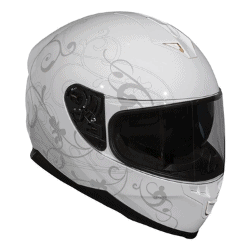
- This helmet has the DOT and ECE certifications.
- It has the open/close ventilation in the mouth area and above the visor. You simply pull it down to let air in or up if you do not need the extra airflow. Hello, crisp fall days!
- Built-in sunshade that retracts
- Removable comfort lining
Fav option: Shoei RF-SR Full Face
The Shoei RF-SR full-face helmet has quite a bit more in features, and the price is higher to reflect that.
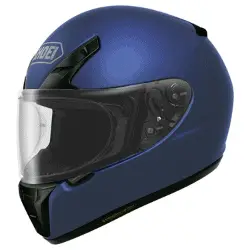
- Snell M2015 certified
- Liner customizations for optimum fit
- Vents and lens material prevent the visor from fogging up
- Lightweight
- Emergency release system
- Wind and waterproof dual-layer seals
- Less road noise
Open Face
Value option: Sedici Aperto
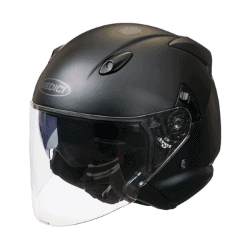
- This helmet has the DOT and ECE certifications
- Includes face shield. I just like not having to remember another piece of gear (goggles)
- Built-in sunshade that retracts
- Removable comfort liner with adjustable fitting
Fav option: Shoei RJ Platinum-R
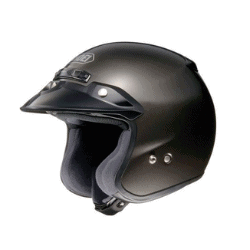
- Snell M2015 certified
- Lightweight
- Adjustable vents
- Less road noise
- Removable comfort liner with adjustable features
- So many colors!
The only thing I’m not crazy about is that this one does not come with the front face protection. So you’ll need to consider your eye protection at a minimum with this helmet.

